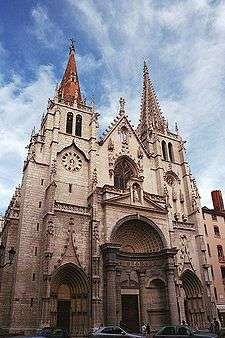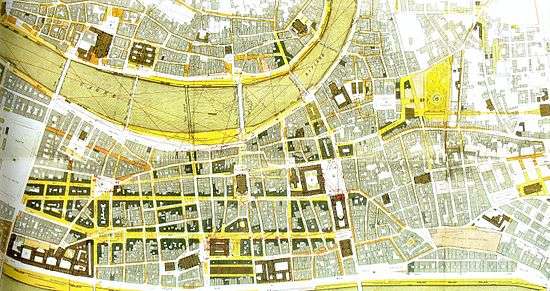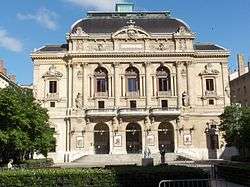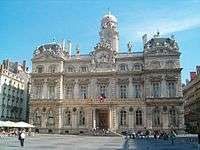Presqu'île
The Presqu’île (French meaning peninsula, literally a combination of words "presque" (almost) and "île" (island)[1] is the heart of Lyon, France. Extending from the foot of the Croix Rousse hill to the confluence of the Rhône and the Saône rivers, it has a preponderance of cafés, restaurants, luxury shops, department stores, banks, government buildings, and cultural institutions. The 1st and 2nd arrondissements of the city (as well as the southern part of the 4th) are located here, along with the Hôtel de Ville (city hall). The spires of the church of St. Nizier, rebuilt from the 14th to the 16th centuries, are at the foot of the former Saône river bridge. Though the business centre is located to the east in the 3rd arrondissement, road signs pointing to the centre of the city take drivers to Place Bellecour in the 2nd.
History


This district was an important counterpoint to the Vieux Lyon district in the Middle Ages and the Renaissance. Many picturesque streets still exist. Among these is the rue Mercière, where printers and booksellers gravitated in the 15th and 16th centuries and which still has some superb buildings. The Museum of Printing, housed in the former Hôtel de la Couronne, explains how Lyon’s first books were printed. Squares, in many cases decorated with fountains, and churches sprinkled throughout evoke the presence of numerous convents, including those of the Dominicans (Jacobins), the Celestines and the Conventual Franciscans (Cordeliers), whose Saint Bonaventure church was rebuilt in the 14th century. Further south, the church of Saint-Martin d’Ainay in the Ainay area was originally the church of Ainay Abbey, a large Benedictine monastery, and is still a jewel of Romanesque art in Lyon.
The Place des Terreaux was created in the 17th century, owing to the construction of two prestigious structures:
- The Hôtel de Ville, or City Hall, was built between 1646 and 1655 by the architect Simon Maupin and decorated by the painter Thomas Blanchet. In 1674, the Great Hall was ravaged by fire, and the façade facing the square was redesigned in the early 18th century by Jules Hardouin Mansart.
- The Saint Pierre Palace, formerly a royal Benedictine abbey, construction of which began in 1659 by the Avignon architect François de Royers de la Valfenière. It now houses the Museum of Fine Arts. The public garden in the former cloister is decorated with the work of famous sculptors and is a quiet, urban oasis. In the 17th and 18th centuries the Place Bellecour was created in honour of King Louis XIV.
Nowadays, the Place des Terreaux hosts several restaurants and an impressive statue of a woman on a chariot, and is a common sightseeing destination within Lyon.
Modern times
Jacques-Germain Soufflot expanded the hospital located near the old Rhône bridge, building the Hôtel-Dieu along the banks of the river. Today, the hospital is closed. Works are underway to renovate the building, which will host a five star hotel, shops, offices, apartments, and the new Cité de la gastronomie. Numerous hôtels particuliers were built in the vicinity of the Place Bellecour. The Hôtel du Gouverneur, built in 1730, now houses the Musée des Tissus (Museum of Textiles) and the Hôtel de Lacroix Laval, designed by Soufflot, is now the Museum of Decorative Arts. In 1855, during France’s Second Empire period, Claude-Marius Vaïsse, Prefect of the Rhône département, created the rue de la République and the rue Edouard Herriot as part of a series of large construction projects. The Stock Exchange, built in 1860, is an example of the Napoleon III style and is in the heart of the banking district. In the 19th century, two theatres were built: the Célestins Theatre and the Grand Theatre, the latter of which is now the opera house, rebuilt in 1993 by Jean Nouvel. These are two of the city’s major cultural centres.
See also
External links
- Informations sur le site Lyon.fr
- Association œuvrant pour la connaissance et la préservation du patrimoine de la Presqu'île
- Site of the Mayor of the second arrondissement
- Hôtels and restaurants
- site tendancepresquile.org
- Site Lyonphotos - The presqu'île under snow
- Lyon : The Presqu'île by vélo'v
- Sur la Presqu'île : some traboules.
References
- Le petit Robert de la langue française 2007


